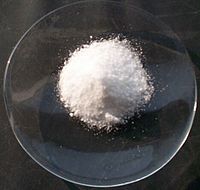
Photo from wikipedia
Apparent molar volumes and apparent molar compressibilities for d-sorbitol in (0.05, 0.1, 0.2 and 0.3) mol·kg−1 aqueous solutions of l-alanine, l-cysteine and l-histidine and NaCl have been determined from measurements… Click to show full abstract
Apparent molar volumes and apparent molar compressibilities for d-sorbitol in (0.05, 0.1, 0.2 and 0.3) mol·kg−1 aqueous solutions of l-alanine, l-cysteine and l-histidine and NaCl have been determined from measurements of solution density at T = (288.15, 298.15, 308.15 and 318.15) K and sound velocity at T = 298.15 K, as a function of the concentration of the sugar alcohol. The data were used to obtain the limiting apparent molar volumes, limiting apparent molar compressibilities and the corresponding transfer parameters. Limiting apparent molar expansibilities and their second order derivatives and volume interaction coefficients were also estimated. These parameters are discussed in terms of d-sorbitol and co-solute (amino acid or sodium chloride) interactions in aqueous solutions.
Journal Title: Journal of Solution Chemistry
Year Published: 2018
Link to full text (if available)
Share on Social Media: Sign Up to like & get
recommendations!